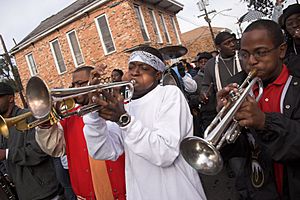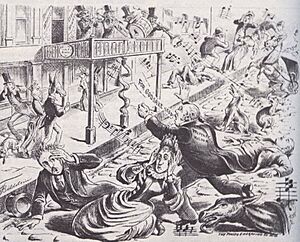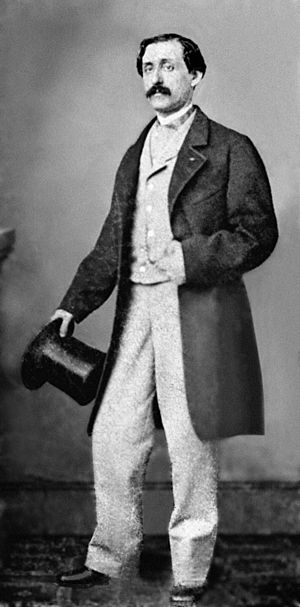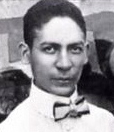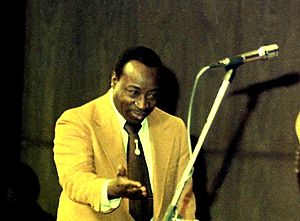Music of New Orleans facts for kids
New Orleans is famous for its amazing music! This city in Louisiana is known as the birthplace of jazz music. Jazz started here with a style called dixieland, also known as traditional jazz. But New Orleans music is more than just jazz. It has many different styles that have grown from jazz or taken their own paths. New Orleans is also a big center for funk music, with some of the first funk bands like The Meters coming from here.
Contents
How New Orleans Music Began
The roots of New Orleans music go back to Congo Square in 1835. This was a place where enslaved people gathered on Sundays to play music and dance. They played African music and local tunes. White composers like Louis Moreau Gottschalk also added to the city's music. All these different styles, including European brass band traditions, mixed together. This mix created the special New Orleans sound we know today.
By 1838, the local newspaper, Picayune, even complained about how many brass bands were playing in the city!
The Story of Jazz Music
The word "jazz" (sometimes spelled "jass" at first) became popular around the 1910s. This was when musicians from New Orleans started becoming famous in other parts of the United States. They needed a new name for their unique style to tell it apart from ragtime, which was popular everywhere. Before that, the New Orleans style was often just called "ragtime." Some musicians, like Sidney Bechet, even called their music "ragtime" their whole lives. People also used local names like "hot music."
The dance music in New Orleans was special even in the 1800s. When this style became "jazz" is still debated. Most historians think New Orleans jazz developed over time. It probably reached its famous form between the 1890s and the mid-1910s.
Around the 1890s, a man named Poree hired a band led by cornet player Buddy Bolden. Many people, including other musicians and jazz historians, believe Bolden was the first important jazz musician. His music wasn't called jazz then. It was like marching band music with brass instruments and dancing. Bolden might even be called a blues player. The exact meaning of the word "jass" (which became "jazz") is still a bit of a mystery.
The Storyville area was important for some visitors to hear the music. But it was not more important than other neighborhoods in the city for jazz to grow. Many instruments were bought cheaply from pawn shops, often old military band instruments.
The Creole people of New Orleans also helped jazz grow a lot. Their music was greatly influenced by Bolden's new style. New Orleans musicians like Louis Armstrong, Sidney Bechet, and Jelly Roll Morton all remembered how Bolden changed music in New Orleans and jazz itself. Armstrong never met Bolden, but his teacher King Oliver told him all about Bolden.
How Sicilian Culture Influenced Jazz
New Orleans saw many people move there from Sicily, Italy, in the late 1800s and early 1900s. The Sicilian capital, Palermo, had a long history of trading cotton and citrus fruits with New Orleans. This led to a direct shipping route between the two cities. Because of this, many Sicilians moved to New Orleans and other American cities.
This migration meant that much of New Orleans jazz was shaped by the music of Sicily. For example, the New Orleans group called the Original Dixieland Jass Band showed this influence. The band's leader, Nick LaRocca, and drummer, Tony Sbarbaro, were both born to Sicilian parents. Their song "Livery Stable Blues" was the first jazz record ever released!
How Cuban Music Influenced Jazz
African American music started using Afro-Cuban music ideas in the 1800s. This happened when the habanera (a Cuban dance rhythm) became popular around the world. The habanera was the first written music to have a rhythm based on an African pattern. In African American music, the habanera rhythm can be seen as a mix of tresillo and the backbeat.
Musicians from Havana, Cuba, and New Orleans would travel between the two cities by ferry every day to perform. So, it's not surprising that the habanera quickly became popular in New Orleans. Music expert John Storm Roberts said that the habanera "reached the U.S. 20 years before the first rag was published."
The famous New Orleans composer Louis Moreau Gottschalk was influenced by his studies in Cuba. He used the tresillo rhythm a lot in his symphonic work La nuit des tropiques (meaning "Night of the Tropics"). Gottschalk was one of the first to seriously use Afro-Caribbean rhythms in New World art music. For over 25 years, while cakewalk, ragtime, and early jazz were developing, the habanera was a regular part of African American popular music.
It's hard to know if tresillo came directly from Cuba or if the habanera just made similar rhythms already in New Orleans music stronger. It's likely that tresillo-based rhythms were played in Congo Square by Caribbean enslaved people. You can find tresillo-like rhythms in some African American folk music. This includes the foot stomping in ring shout and drum and fife music after the Civil War. Tresillo is also heard clearly in New Orleans second line music.
Early New Orleans jazz bands played habaneras. The tresillo/habanera pattern was a key rhythm in jazz around 1900. When comparing New Orleans music with the music of Cuba, Wynton Marsalis said that tresillo is the New Orleans "clave." A clave is a guide pattern in music.
The New Orleans musician Jelly Roll Morton thought the tresillo/habanera (which he called the "Spanish tinge") was a very important part of jazz. You can hear the habanera rhythm and tresillo in his left hand on songs like "The Crave" (recorded in 1938). Morton said, "Now in one of my earliest tunes, 'New Orleans Blues', you can notice the Spanish tinge. In fact, if you can't manage to put tinges of Spanish in your tunes, you will never be able to get the right seasoning, I call it, for jazz."
We may never know the exact start of jazz syncopation (off-beat rhythms). But there is proof that the habanera/tresillo rhythm was there from the beginning. Buddy Bolden, the first known jazz musician, is famous for creating the big four. This was the first drum pattern that moved away from the usual on-the-beat march rhythm.
Music historian Gunther Schuller said that simpler African rhythms probably stayed in jazz. This is because they could be easily mixed with European rhythms.
The Second Line Tradition
In the very early days of brass bands, in the 'nineties and even before, the music was mostly written–I mean in the kind of band my father played in. As time went on, there was more improvising.
Brass marching bands were around long before jazz music. They were first used in the military. But in New Orleans, many famous musicians started in brass marching bands. These bands played sad songs called dirges and also happy, upbeat tunes for New Orleans jazz funeral parades. This tradition started in the 1890s and continued with musicians like Louis Armstrong, Henry "Red" Allen, and King Oliver. Marching bands are still a big part of New Orleans today. Musicians like the Marsalis family did some of their first work in these bands.
Much of New Orleans music today comes from these early marching bands. In the late 1800s, marching bands often paraded through the city streets in what are called second line parades. Some of the first bands came from the Tremé neighborhood. Bands like the Excelsior, Onward, and Olympia brass bands were born in the city. The Onward and Olympia bands still perform today! Modern brass bands include the Dirty Dozen Brass Band and the Rebirth Brass Band. The Rebirth Brass Band was started by Phillip "Tuba Phil" Frazier, Keith Frazier, and Kermit Ruffins.
The history of marching bands in New Orleans is very rich. These bands play at almost every big event in the city. They perform at funerals, picnics, carnivals, and parades. Jazz bands and brass bands have influenced each other. Early jazz bands started to go beyond the usual 6/8 time signature of marching bands. Instead, New Orleans jazz bands began to "rag" their music. This meant they used the 2/4 rhythm of ragtime, which led to musicians making up music on the spot (improvisation). In return, early jazz bands influenced marching bands, who also started to improvise more. This shows how jazz music is a symbol of freedom.
What is Dixieland Jazz?
You must understand that there was always a bad feeling between the northern part of the country and the southern part. After the Civil War they still battle against each other, and to those boys everything was Dixie and Dixieland as far as they were concerned. But to tell the facts, as far as we blacks were concerned it was New Orleans music — New Orleans, not Dixieland Jazz. Those boys, they made that up.
The word "dixieland" was first used by Dan Emmett in his song "Dixie's Land" in 1859. It was not a positive word for African-Americans at the time. It referred to parts of the South where enslaved people had not yet gained their freedom.
Dixieland music can be described in different ways. It started in New Orleans, first heard in the music of King Oliver. It quickly spread north as African Americans moved to cities like Chicago. Today, the term "dixieland" describes any jazz style that comes from early New Orleans jazz.
New Orleans musicians usually don't use the term "dixieland" much. There's good reason to believe the name was given to them by others. For example, the first band to use the term in their name was the all-white Original Dixieland Band. This band played a big part in making "dixieland" a term for New Orleans jazz. However, they did not create the music. Their main achievement was being the first to record New Orleans music. This happened in New York City in 1917. Even though musician Paul Barnes criticized them, he also said they were a "first class band."
A young musician named Louis Prima was an early student of Dixieland. His older brother Leon also played. They lived outside the French Quarter in a neighborhood with Italian-American and African-American musicians. Louis Prima played trumpet and cornet all over New Orleans. He then followed his hero Armstrong and moved North to advance his career. He played at the Famous Door in New York City. Later, he moved to Las Vegas, where he often performed with another New Orleans musician, saxophonist Sam Butera.
Rhythm & Blues and Rock & Roll
After World War II, a new music style came from New Orleans. Famous musicians like Fats Domino helped create "Rhythm and Blues" (R&B). R&B was a very important ancestor of rock and roll, and some even say it was the first form of rock and roll. Besides local musicians, early rock and roll stars from other places recorded many of their first hits in New Orleans. They used bands made up of New Orleans musicians.
In 1949, New Orleans jazz musician and Fats Domino's producer, Dave Bartholomew, brought the tresillo rhythm directly from Cuban music into early R&B.
Music writer Robert Palmer noted that Dave Bartholomew used this rhythm as a saxophone part in his 1949 song "Country Boy." Bartholomew then helped make it the most used rhythm in 1950s rock and roll. On many songs by Fats Domino, Little Richard, and others, Bartholomew gave this repeating three-note pattern to the bass, electric guitars, and even the baritone saxophone. This created a very strong bass sound. He remembered first hearing this rhythm as a bass part on a Cuban record.
In an interview, Bartholomew explained how he mixed tresillo with swing rhythm. He heard the bass playing that part on a "rumba" record. For "Country Boy," he had his bass and drums play a regular swing rhythm. Then he wrote the "rumba" bass part for the saxophones to play on top of the swing. Later, especially when rock and roll came along, he made the "rumba" bass part stronger and stronger. He would have the bass, an electric guitar, and a baritone saxophone all playing the same rhythm together.
Bartholomew called the Cuban son music "rumba," which was a common mistake at the time. In Bartholomew's 1949 song "Oh Cubanas," which used the tresillo rhythm, you can clearly hear him trying to mix African American and Afro-Cuban music.
Hip-Hop Music in New Orleans
New Orleans became a big part of the hip hop world thanks to record labels like No Limit Records and Cash Money Records. These labels released many albums by young New Orleans rappers starting in the mid-1990s.
Some important New Orleans artists from No Limit included Mia X, Mystikal, Master P, Soulja Slim, C-Murder, and Silkk the Shocker. Cash Money also signed and released albums by several New Orleans artists. These included BG, Juvenile, Turk, Big Tymers, and Lil' Wayne.
The city is also the birthplace of bounce music, a style that is becoming very popular. Former Cash Money producer Mannie Fresh is often given credit for making Bounce music popular outside of New Orleans. Drake, who is also signed to Cash Money, recently worked with New Orleans Bounce producer Blaqnmild on his international hit songs "Nice For What" and "In My Feelings". Rapper Jay Electronica, signed to Jay-Z's Roc Nation label, has also become well-known in the hip-hop scene.
Other rappers from New Orleans include Currensy, Corner Boy P, Young Roddy, Trademark Da Skydiver, and Fiend. Most of the Jet Life music group is from New Orleans or nearby areas.
Heavy Metal Music in New Orleans
New Orleans has a very active metal music scene. It really started to grow in the late 1980s. Bands like Eyehategod, Down, Exhorder, Crowbar, Acid Bath, Soilent Green, Goatwhore, Kingdom of Sorrow, Graveyard Rodeo, and Superjoint Ritual are either based in the city or have most of their members from the area. Musicians like Mike Williams, Jimmy Bower, Brian Patton, Phil Anselmo, Kirk Windstein, Pepper Keenan, Pat Bruders, Stanton Moore, and Kyle Thomas live in New Orleans.
The city is known for its "Louisiana sound." This sound was started by Exhorder, who were the first band to mix doom metal and fast thrash metal. Many of these metal groups share a style that gets ideas from Black Sabbath, Melvins, hardcore punk, and Southern rock. However, there are still differences in the sounds of the bands. Eyehategod uses very harsh vocals and loud guitar sounds. Down has a style closer to classic rock. Crowbar's music is mostly slow with a deep, low guitar sound. Soilent Green's music is closer to grindcore.
It's very common for a member of one of these bands to also be part of another band from New Orleans or Louisiana. Musicians from different bands often work together on projects.


